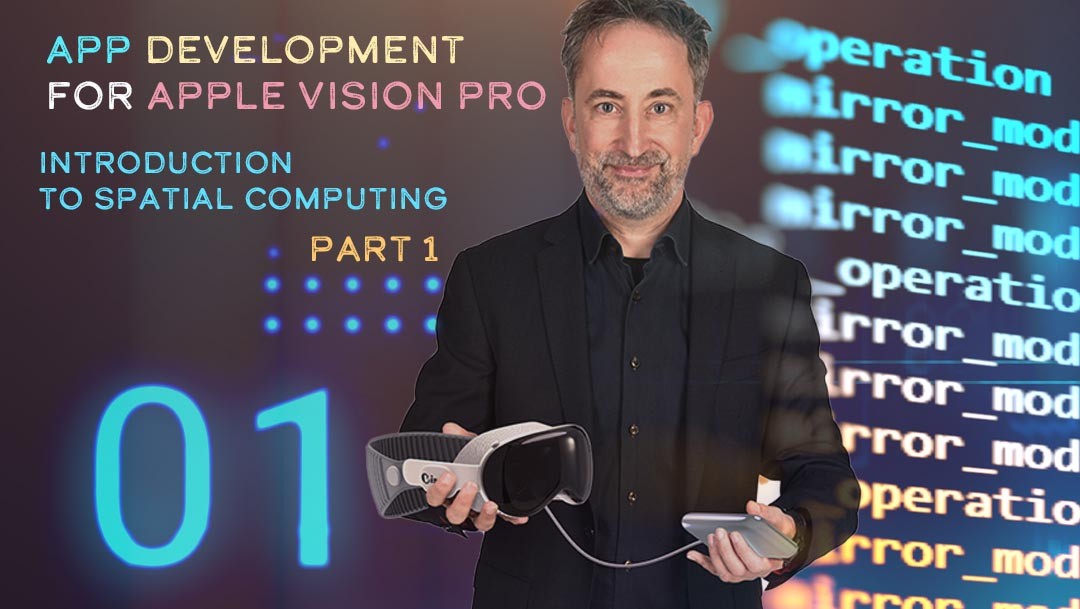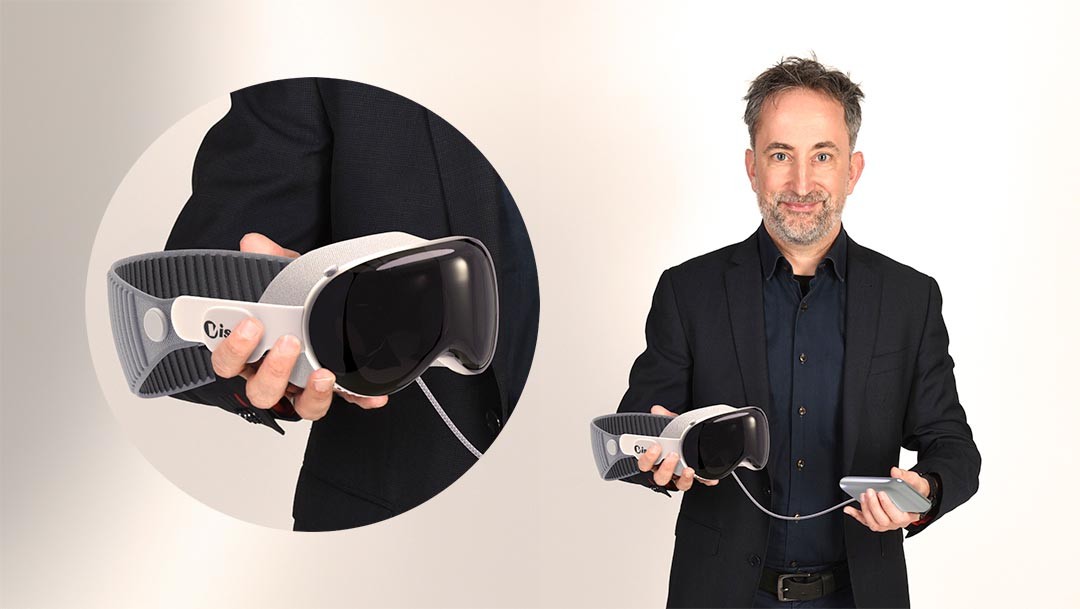App Development for AVP – Part 1: Introduction to Spatial Computing I by Ulrich Buckenlei (MBA)
Introduction to Spatial Computing
Definition and Significance of Spatial Computing
Spatial Computing describes an advanced form of computing technology that integrates the physical world around us as part of digital interaction. It enables the merging of digital and physical realities by incorporating digital objects into three-dimensional space. This concept expands traditional 2D interactions with devices to a comprehensive 3D experience, where users interact with digital content as if it were physically present.
Differences and Advantages of Spatial Computing Over Traditional Computing Approaches
Spatial Computing fundamentally transforms our understanding and interaction with technology. It overcomes the limitations of conventional user interfaces and offers a more natural, intuitive form of digital interaction:
- Enhanced Reality Experience: Unlike traditional computing, which is based on screens and flat displays, Spatial Computing enables an immersive experience where users can interact with their environment and digital objects in a natural way.
- Environment-Aware Audio: AI-driven adjustment of audio settings based on environmental conditions such as noise levels and room acoustics.
- Variety of Interactions: While traditional computing technologies primarily use keyboard, mouse, and touchscreen, Spatial Computing captures movements, gestures, and the entire body of the user for intuitive control.
These aspects of Spatial Computing lay the foundation for developing applications that go far beyond what is possible with traditional computing approaches, opening new horizons for developers and users alike. On this exciting basis, the Apple Vision Pro (AVP) presents itself as a key tool that bridges the gap between the possibilities of Spatial Computing and its practical implementation for developers and users.
Overview of Spatial Computing with the Apple Vision Pro
Apple’s First Mixed Reality Headset
Apple Vision Pro, Apple’s first mixed reality headset, marks a significant milestone in the evolution of augmented and virtual reality technologies. Designed for comfort and immersion, and powered by the robust visionOS, the AVP extends the boundaries of how we experience and create interactive content. It offers seamless integration of virtual elements into the real world, enabling an entirely new level of interaction and engagement.
Technical Innovations of the Apple Vision Pro Spatial Computing Headset
The Apple Vision Pro sets new standards in the world of Spatial Computing, providing a comprehensive framework for developers and users with its advanced features and design:
- Immersive Display: The Vision Pro utilizes high-resolution screens combined with support for Spatial Audio with dynamic head-tracking to offer an unparalleled immersive experience. These technologies enable a lifelike representation of virtual objects in the real world.
- Precise Tracking: The integration of advanced sensor technology allows for accurate motion tracking and interaction. This includes a six-microphone array with beamforming and support for an H2-to-H2 ultra-low-latency connection to the 2nd generation AirPods Pro, blurring the boundaries between the real and virtual worlds.
- visionOS: As a specially developed operating system for the AVP, visionOS simplifies and enriches the development and use of mixed reality applications. It presents a revolutionary three-dimensional user interface that dynamically responds to natural light conditions and seamlessly integrates content into the user’s real environment.
- Developer Tools: Apple provides an extensive set of resources and tools to support the creation of applications for the AVP. This includes integration with familiar environments and the ability to adapt existing iPhone and iPad apps to the new interaction model of Vision Pro.
Based on the innovative features of the Apple Vision Pro, which provide a solid foundation for the development of groundbreaking applications, we now turn to the fundamentals of visionOS. This specially developed platform is the heart of the Apple Vision Pro and plays a crucial role in redefining our interactions with digital content. visionOS embodies an ambitious design philosophy aimed at reshaping user experiences and interaction models in the world of Spatial Computing.
Fundamentals in Spatial Computing App Development with visionOS
Developing Accessible Mixed Reality Applications
visionOS has been developed from the ground up with the goal of providing an intuitive and seamless experience for mixed reality applications. The design philosophy behind visionOS focuses heavily on usability and natural interactions. It’s about creating an operating system that is not only powerful and versatile but also simple and pleasant to use.
Design Philosophy and User Experience in Spatial Computing App Development with visionOS
A core aspect of visionOS is the novel interaction models and interfaces specifically designed for Spatial Computing. Users can interact with digital content in ways that go far beyond traditional touchscreens and peripheral devices. visionOS enables control through gestures, gaze directions, and voice commands, creating a dynamic and immersive user experience perfectly tailored to the mixed reality world of the Apple Vision Pro.
- Design Philosophy: Focused on usability and intuitive interaction, visionOS redefines the interaction with technology. By considering ergonomic principles and user-centricity, visionOS provides a platform that emphasizes adaptability and personalized experiences.
- User Experience: Offers a seamless and immersive experience through innovative interfaces and interaction models. visionOS uses machine learning and artificial intelligence to recognize user preferences and dynamically adapt the user experience, making each interaction both natural and intuitive.
- New Interaction Models: Enables control through gestures, gaze, and speech to create natural communication with digital content. Furthermore, visionOS introduces advanced hand and eye tracking technologies that allow precise control and interaction with virtual objects without the need for physical controllers.
- Interfaces: Designed for Spatial Computing, visionOS seamlessly integrates digital content into the physical world. This is achieved through the support of augmented reality (AR) environments, enabling digital objects and information to be projected directly into the user’s field of view, providing contextually relevant and real-time information.
The innovative features and interaction models of visionOS form the perfect foundation for developing new applications that seamlessly connect digital and physical worlds. These technological advances enable developers to create user experiences that are deeper, more intuitive, and more captivating than ever before. In this context, a wide range of opportunities opens up for developers eager to leverage the power of visionOS and the Apple Vision Pro.
Opportunities for Spatial Computing App Developers
Support from Apple and Visoric in Developing Spatial Computing Apps
Tools and Resources provided by Apple or XR development teams like the Visoric expert team in Munich open new horizons in app development. These tools are specifically designed to leverage and expand upon the unique capabilities of the Apple Vision Pro, allowing developers to redefine the boundaries of what is possible.
Tools and Resources from Apple for Spatial Computing App Development
Apple and Visoric provide a wide range of developer tools and resources specifically designed for creating mixed reality applications. These include, among others:
- Development Kits and APIs: These provide direct access to the hardware features of the Apple Vision Pro, including cameras, sensors, and displays, as well as visionOS-specific features such as spatial audio and tracking capabilities.
- Comprehensive Documentation and Tutorials: Apple offers detailed guides and learning materials to help developers quickly start developing applications for visionOS and fully exploit the platform’s capabilities.
- Support and Community Access: Developers have access to a broad community and support resources, including forums and direct support from Apple, to get help and feedback on their projects.
Getting Started and Best Practices in Spatial Computing App Development
For developers looking to dive into the world of mixed reality application development, Apple provides clear guidelines and best practices:
- Prototyping and Design Considerations: Exploring design possibilities in the context of Mixed Reality and Spatial Computing is crucial. Developers are encouraged to create interactive prototypes and seek user feedback early in the development process.
- Performance and Optimization: Given the demanding nature of mixed reality applications, performance optimizations are critical. Apple offers advice on efficient use of system resources and ensuring a smooth user experience.
- Accessibility and Inclusion: Developing accessible applications suitable for a wide range of users is a priority. visionOS supports developers in creating applications that are inclusive and accessible to people with diverse needs.
With the opportunities and resources provided by Apple and Spatial Computing, such as the Visoric GmbH, stepping into a new era of app development is made easier. Professional frameworks and Spatial Computing pipelines enable the creation of applications that are not only state-of-the-art but also significantly alter the way we learn, work, and interact. Using visionOS in combination with the Apple Vision Pro opens doors to new dimensions of digital interaction and lays the foundation for future innovations. This pioneering role in development marks the beginning of a new chapter in the history of human-technology interaction.
Future Perspectives and Potential
Future Perspectives and the Potential of Spatial Computing
The introduction of visionOS and the Apple Vision Pro symbolizes the dawn of a new era in technology, especially in the realm of Spatial Computing. These innovations have the potential to fundamentally change the interaction with technology and unlock new use cases that were previously unimaginable.
How visionOS and the AVP Could Change Technology Interaction
visionOS and the Apple Vision Pro revolutionize how users interact with digital content by creating a seamless connection between the digital and physical worlds. These technologies enable users to navigate their surroundings intuitively, interact with digital objects, and experience information in ways that transcend the limitations of traditional displays.
Examples of Innovative Use Cases
- Education and Training: Spatial Computing can visualize complex concepts and processes, facilitating learning and understanding. Applications can, for example, depict historical events or scientific phenomena in a three-dimensional space, creating an immersive learning experience.
- Healthcare: Physicians could use Spatial Computing to view and analyze medical images and diagnoses in 3D, potentially improving the precision and effectiveness of treatments.
- Retail and Design: Customers could view and customize products in a virtual space before making a purchase decision, while designers could create room concepts and prototypes in a fully interactive 3D environment.
- Remote Collaboration: Teams that are geographically distributed could collaborate in a virtual space as if they were in the same room, improving the efficiency and effectiveness of collaboration.
With the introduction of visionOS and the Apple Vision Pro on the horizon of technological development, we have already gained insights into the revolutionary possibilities that Spatial Computing offers for app development.
The discussions so far have shown how these technologies redefine the interaction between humans and the digital world and enable innovative use cases in various fields.
In the next part of our article series on app development for the Apple Vision Pro, we will focus on design principles and user experience. We will report, among other things, on how Apple Vision Pro app developers at Visoric GmbH utilize the capabilities of visionOS to design intuitive and appealing user interfaces that fully exploit the immersive potential of Mixed Reality.
Stay tuned to dive deeper into the world of Spatial Computing and discover how you can create extraordinary experiences that captivate users in a completely new way.
About the Author:
Ulrich Buckenlei, born on January 7, 1975, in Regensburg, is a renowned digitalization strategist and visionary in the field of Industrial Metaverse and Spatial Computing.
He holds a degree in Technical Editing and an MBA from the Technical University of Munich.
As the founder, CEO, and Creative Director of VISORIC GmbH, he has made a name for himself in the industry. VISORIC specializes in AR, VR, and 3D real-time visualization, advising a wide range of clients worldwide, including well-known brands, large authorities, publishers, organizations, as well as medium-sized and smaller companies.
Ulrich Buckenlei’s clients include notable companies such as BMW, Audi, Siemens, the news magazine Der Spiegel, Magic Leap, Discovery Channel, ZDF, and the Bavarian Ministry of Economic Affairs. Buckenlei is actively committed to digital transformation and the development of innovative technologies.
Digitalization strategist Ulrich Buckenlei with the Spatial Computing Headset Apple Vision Pro.
Photo: © Visoric GmbH I Munich 2024
We look forward to your feedback and are happy to provide personal advice if you have any questions.
Contact Persons:
Ulrich Buckenlei (Creative Director)
Mobile: +49 152 53532871
Email: ulrich.buckenlei@visoric.com
Nataliya Daniltseva (Project Manager)
Mobile: + 49 176 72805705
Email: nataliya.daniltseva@visoric.com
Address:
VISORIC GmbH
Bayerstraße 13
D-80335 Munich



